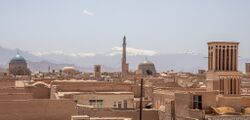Yasid
| Nation: | |
| Population: | 100,000 |
| Predominant language: | Common tongue Hatayyian |
|
| |
| Main roads: | |
| Major districts: | |
|
| |
| Current mayor: | Muhammad Sadiq al-Umar |

| |
| Map versions: | |
Yasid (Hatayan: يزد, Yazid) is an ancient city located in Aerla. Founded by the Hatayyians in the 1500s AN, it served as a major trade center in Hatay, as well as The Green. The city is special due to the fact it is the only city in Aerla in which the mayor is of any nobility, with Sheikh Jiyaad al-Umar being granted suzerainty of the city.
History
Founded as capital of the Umar region by the Hatayyians, the city was a notable population center in Central Keltia during the golden years of Hatay. Much like other cities in the region at the time (such as Mola Ram, another regional capital), the city grew due to the gas and oil industry. The city was ruled by the powerful Umar family, who were appointed as Sheiks to the region. However, after the fall of Hatay, most of the Umar region was overrun by tribal warlords. However, the city itself remained well defended from these warlords and continued to prosper as a major hub for caravan traders up into the 17th Century AN.
The Grand Army of Aerla would soon make expeditions into the region and attempt to contact the Sheikh of the city, who at that point was Abbas al-Umar. An unnamed army arbiter was sent to the city in hopes to establish contact with the sheikh, however this diplomat (along with his detail) where executed by the Sheik's guards. This incident prompted the deployment of State Security Directorate operatives to assassinate the Sheikh. This mission proved successful, and his son, Jadid al-Umar, was forced to swear fealty to the Aerlan State. Per the agreement, he would have the city under his control under the careful watch of Noursala. He also was coerced into hosting a GAR regiment inside the city as a police force.
After the passage of the Municipal Reform Act in 1724 AN, the city became the capital of the enlarged Hatay Municipality. Under this new arraignment, the city would grow and modernize at an exponential rate with old clay and brick buildings being replaced by modern high rises, bazaars were transformed into shopping malls, and many of the dirt roads being paved. The Great Mosque of Yazd, which had been slowly deteriorating for decades, was almost completely rebuilt with modern amenities such as running water and a new sound system for the daily prayer calls.
Jadid al-Umar would develop Stage 3 Leukemia in the early 1730 ANs and would designate his teenage son, Muhammad Sadiq al-Umar, as his successor. Jiyaad would pass away in 1737 AN, and Muhammad Sadiq would take his place as Sheikh of the city. In a telephone call with President Basil Fitzroy, Muhammad confirmed his fealty to Noursala and promised to uphold his father's laws and modernization programs.